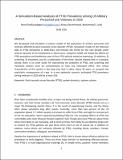| dc.description.abstract | We developed and simulated a systems model of the population of military personnel and veterans affected by post-traumatic stress disorder (PTSD). Simulation results fit the historical data on PTSD prevalence in 2000-2014, and forecast the trends for the next decade under several scenarios of US involvement in future wars. Using the model, we tested the effects on PTSD prevalence and healthcare costs of four PTSD policies aimed at improving: 1) resiliency, 2) screening, 3) treatment, and 4) a combination of the three. Results showed that in a postwar period, there is no silver bullet for overcoming the problems of PTSD, and screening and treatment policies must be revolutionized to have any noticeable effect. One critical characteristic of this system is the long time that it takes, about 40 years, to vanquish the psychiatric consequences of a war. In a very optimistic scenario, estimated PTSD prevalence among veterans in 2025 will be at least 10%. | en_US |
